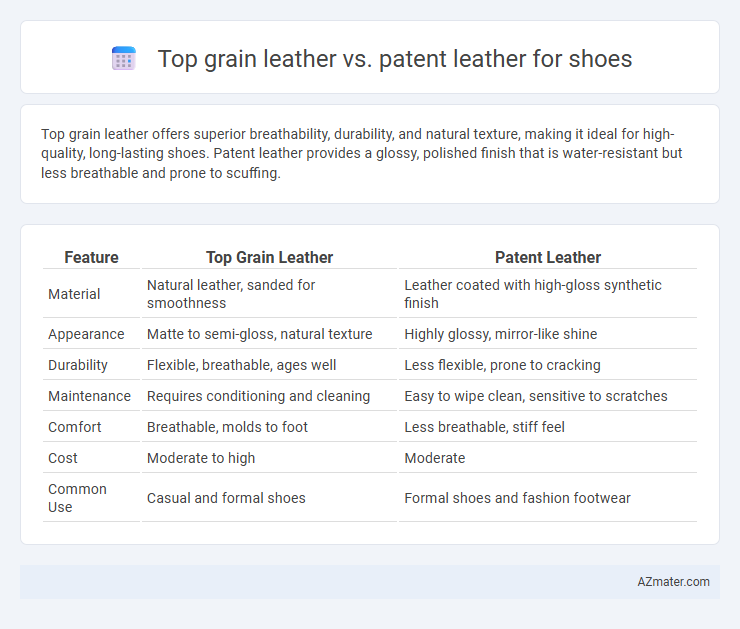Top grain leather offers superior breathability, durability, and natural texture, making it ideal for high-quality, long-lasting shoes. Patent leather provides a glossy, polished finish that is water-resistant but less breathable and prone to scuffing.
Table of Comparison
| Feature | Top Grain Leather | Patent Leather |
|---|---|---|
| Material | Natural leather, sanded for smoothness | Leather coated with high-gloss synthetic finish |
| Appearance | Matte to semi-gloss, natural texture | Highly glossy, mirror-like shine |
| Durability | Flexible, breathable, ages well | Less flexible, prone to cracking |
| Maintenance | Requires conditioning and cleaning | Easy to wipe clean, sensitive to scratches |
| Comfort | Breathable, molds to foot | Less breathable, stiff feel |
| Cost | Moderate to high | Moderate |
| Common Use | Casual and formal shoes | Formal shoes and fashion footwear |
Introduction to Top Grain and Patent Leather
Top grain leather, derived from the upper layer of the hide, offers durability, breathability, and a natural appearance, making it ideal for high-quality shoes. Patent leather, treated with a glossy, shiny finish, provides a sleek and polished look, commonly used for formal footwear and dress shoes. Both materials bring unique qualities to shoe design, balancing style with function depending on the desired aesthetic and use.
What is Top Grain Leather?
Top grain leather is the second-highest quality of leather, made by sanding and refinishing the natural grain for a smooth, durable surface that resists stains and breathes well. In shoes, top grain leather offers a balance of durability, flexibility, and breathability, making it ideal for long-lasting, comfortable footwear. Patent leather, by contrast, features a glossy, coated finish that is less breathable but provides a sleek, polished appearance suited for formal occasions.
What is Patent Leather?
Patent leather is a type of coated leather known for its glossy, mirror-like finish achieved through a lacquer or plastic coating applied to the surface. Unlike top grain leather, which maintains a natural texture and breathability, patent leather is less porous and more resistant to water and stains but can be prone to cracking over time. This makes patent leather ideal for formal shoes requiring a sleek, polished appearance but less suited for everyday wear requiring flexibility and durability.
Key Differences: Top Grain vs Patent Leather
Top grain leather offers durability and breathability with a natural, matte finish, making it ideal for long-lasting, comfortable shoes. Patent leather features a high-gloss, shiny surface achieved through a lacquer coating, providing a sleek, polished appearance but less breathability. Key differences include top grain leather's flexibility and moisture-wicking properties versus patent leather's rigidity and water resistance, impacting shoe style and performance.
Durability and Longevity Comparison
Top grain leather offers superior durability and long-lasting wear due to its natural fiber strength and ability to develop a rich patina over time. Patent leather, coated with a high-gloss finish, provides excellent water resistance but is prone to cracking and peeling with extended use. Shoes made from top grain leather generally outperform patent leather in longevity, maintaining structural integrity under frequent wear and environmental stress.
Comfort and Breathability
Top grain leather offers superior comfort and breathability for shoes due to its natural grain and porous structure, allowing better air circulation and moisture absorption. Patent leather features a glossy, sealed surface that limits airflow, often resulting in less breathability and potential discomfort during extended wear. Choosing top grain leather enhances shoe comfort through improved temperature regulation and moisture management.
Appearance and Style
Top grain leather offers a natural, matte finish with subtle texture variations that create a sophisticated and classic appearance for shoes, enhancing their timeless style. Patent leather features a high-gloss, mirror-like shine that provides a bold, polished look ideal for formal and statement footwear. The smooth, reflective surface of patent leather contrasts sharply with the more subdued and durable aesthetic of top grain leather, catering to different fashion preferences and occasions.
Maintenance and Care Tips
Top grain leather shoes require regular cleaning with a damp cloth and conditioning with leather cream to maintain suppleness and prevent cracking, while avoiding excessive water exposure to preserve texture. Patent leather shoes benefit from gentle wiping with a soft cloth and occasional use of a patent leather cleaner or mineral oil to retain their high-gloss finish and prevent scuff marks. Storing both types in breathable shoe bags and using shoe trees helps maintain shape and prolongs shoe life.
Best Use Cases for Each Type
Top grain leather offers durability and breathability, making it ideal for everyday dress shoes and casual footwear that require comfort and long-lasting wear. Patent leather features a glossy, high-shine finish perfect for formal occasions, evening events, and fashion-forward designs where a polished appearance is essential. Both materials serve distinct purposes: top grain leather excels in versatility and comfort, while patent leather is best suited for statement-making, stylish shoes.
Which Leather is Right for Your Shoes?
Top grain leather offers durability, breathability, and a natural look, making it ideal for everyday shoes and those seeking long-lasting comfort and subtle sophistication. Patent leather features a glossy, high-shine finish, perfect for formal occasions or stylish shoes that demand attention but requires more care to maintain its polished appearance. Choosing between the two depends on your need for durability and comfort versus aesthetic appeal and formality in your footwear.

Infographic: Top grain leather vs Patent leather for Shoe
 azmater.com
azmater.com